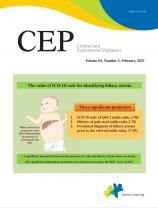The current era has seen a marked increase in pediatric heart transplantation success and survival rates despite variety in recipient heart disease and more limited resources in pediatric patients. Advances in surgical techniques, immunosuppressant treatment after transplantation, and the early detection of graft failure contribute to this improvement. Kim [1] recently reviewed issues that affect long-term outcomes such as immunosuppression and the surveillance of graft rejection. Considering the severe limitations of suitable donor hearts, the first step towards achieving optimal outcomes involves reducing waitlist mortality rates.
Pediatric waitlist mortality rates are 5%ŌĆō30% and vary among countries, regions, and institutions [2-4]. Significant risk factors for such mortality include the use of extracorporeal membrane oxygenation (ECMO) or ventilator support, congenital heart disease (CHD), patient weight less than 3 kg, non-White race, United Network of Organ Sharing status of 1A, and need for dialysis [5,6]. However, there has been a significant decrease in waitlist mortality rates with changes in donor allocations and the use of ventricle assist devices (VADs) as a bridge to transplantation [7,8]. The latter resulted in a large decrease in waitlist mortality rates as well as increased posttransplantation survival rates than by bridging with ECMO.
The analysis of preliminary data in our institute until December 2019 (Table 1) revealed a 40.5% waitlist mortality rate. Mechanical circulatory support (MCS) was used in 9 patients (60.0%), and the main MCS was ECMO since true pediatric VAD was not available at that time in Korea. Mean age at transplantation registration and mean time to death after registration did not differ between patients with MCS and those without MCS (3.2 years vs. 2.2 years and 142.0 days vs. 153.5 days, P>0.05). The mean MCS duration was 48 days, and most causes of mortality in our patients were related with MCS. We were unable to prove that ECMO use was related with higher waitlist mortality rates than was VAD use due to the small number of patients.
Complex CHD that cannot be treated is more risky than various forms of pediatric cardiomyopathy. Patients with complex CHD are generally at higher risk of an increased rate of histocompatibility antigen sensitization. Researchers have suggested antibody depletion and use of the first suitable donor heart regardless of cross-match results for highly sensitized patients [9]. ABO-incompatible donor heart transplantation has been performed, especially in young infants, and showed good results [10]. ABO-incompatible heart transplantation has been standard among children up to 2 years of age in the United States. There are no uniform criteria of a favorable donor heart for pediatric heart transplantation, and the decision of suitability remains subjective. The decision to perform transplantation has been based on donor heart function, weight ratio, and inotrope use, but extended-criteria donors are now being used in adult patients [11]. Therefore, various modifications of donor heart criteria and an increased use of marginal donor hearts can contribute to reductions in waitlist mortality rates. Long-term studies on the long-term survival of such transplants should be continued.
In adult heart transplantation, donation after circulatory death (DCD) is becoming more widely accepted and relatively more prevalent in Europe. A case report described a child who underwent successful heart transplantation of DCD [12]. Although more studies are needed, great advances in pediatric heart transplantation could be achieved with DCD in the future.
In conclusion, efforts to minimize waitlist mortality should consistently aim to not compromise long-term outcomes.





 PDF Links
PDF Links PubReader
PubReader ePub Link
ePub Link PubMed
PubMed Download Citation
Download Citation


